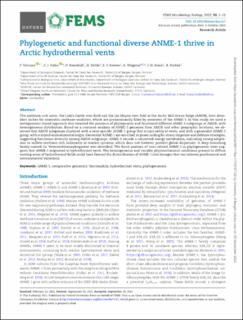| dc.contributor.author | Vulcano, Francesca | |
| dc.contributor.author | Hahn, Cedric Jasper | |
| dc.contributor.author | Roerdink, Desiree Lisette | |
| dc.contributor.author | Dahle, Håkon | |
| dc.contributor.author | Reeves, Eoghan | |
| dc.contributor.author | Wegener, Gunter | |
| dc.contributor.author | Steen, Ida Helene | |
| dc.contributor.author | Stokke, Runar | |
| dc.date.accessioned | 2022-12-19T08:50:52Z | |
| dc.date.available | 2022-12-19T08:50:52Z | |
| dc.date.created | 2022-11-03T15:41:40Z | |
| dc.date.issued | 2022 | |
| dc.identifier.issn | 0168-6496 | |
| dc.identifier.uri | https://hdl.handle.net/11250/3038391 | |
| dc.description.abstract | The methane-rich areas, the Loki's Castle vent field and the Jan Mayen vent field at the Arctic Mid Ocean Ridge (AMOR), host abundant niches for anaerobic methane-oxidizers, which are predominantly filled by members of the ANME-1. In this study, we used a metagenomic-based approach that revealed the presence of phylogenetic and functional different ANME-1 subgroups at AMOR, with heterogeneous distribution. Based on a common analysis of ANME-1 genomes from AMOR and other geographic locations, we observed that AMOR subgroups clustered with a vent-specific ANME-1 group that occurs solely at vents, and with a generalist ANME-1 group, with a mixed environmental origin. Generalist ANME-1 are enriched in genes coding for stress response and defense strategies, suggesting functional diversity among AMOR subgroups. ANME-1 encode a conserved energy metabolism, indicating strong adaptation to sulfate-methane-rich sediments in marine systems, which does not however prevent global dispersion. A deep branching family named Ca. Veteromethanophagaceae was identified. The basal position of vent-related ANME-1 in phylogenomic trees suggests that ANME-1 originated at hydrothermal vents. The heterogeneous and variable physicochemical conditions present in diffuse venting areas of hydrothermal fields could have favored the diversification of ANME-1 into lineages that can tolerate geochemical and environmental variations. | en_US |
| dc.language.iso | eng | en_US |
| dc.publisher | Oxford University Press | en_US |
| dc.rights | Navngivelse 4.0 Internasjonal | * |
| dc.rights.uri | http://creativecommons.org/licenses/by/4.0/deed.no | * |
| dc.title | Phylogenetic and functional diverse ANME-1 thrive in Arctic hydrothermal vents | en_US |
| dc.type | Journal article | en_US |
| dc.type | Peer reviewed | en_US |
| dc.description.version | publishedVersion | en_US |
| dc.rights.holder | Copyright 2022 The Author(s) | en_US |
| dc.source.articlenumber | fiac117 | en_US |
| cristin.ispublished | true | |
| cristin.fulltext | original | |
| cristin.qualitycode | 2 | |
| dc.identifier.doi | 10.1093/femsec/fiac117 | |
| dc.identifier.cristin | 2068810 | |
| dc.source.journal | FEMS Microbiology Ecology | en_US |
| dc.relation.project | Norges forskningsråd: 315427 | en_US |
| dc.relation.project | Trond Mohn stiftelse: TMS2020TMT13 | en_US |
| dc.identifier.citation | FEMS Microbiology Ecology. 2022, 98 (11), fiac117. | en_US |
| dc.source.volume | 98 | en_US |
| dc.source.issue | 11 | en_US |

